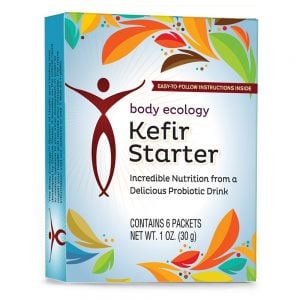3 Ways Candida Albicans Outwits Your Defenses | Candida Spores
The spectrum of disorders related to Candida overgrowth is wide. Candida albicans is opportunistic yeast that is found in every healthy human being.
The problem with Candida overgrowth is that in the most extreme cases it can be deadly. (1)
Once Candida has spread within the body, it can deeply infiltrate healthy tissue. Repairing the gut and controlling inflammation with the help of good bacteria found in fermented foods like kefir, made from the Kefir Starter, will give Candida less room to grow.
Because Candida is native to the mouth, the gut, and the vaginal tract, it is common to see Candida overgrowth in otherwise healthy individuals. (2) For example, if you are fighting the flu or are under more stress than usual, Candida overgrowth can show up as thrush in the mouth or as a vaginal yeast infection.
How Candida Invades Your Body
Once this yeast has the chance to dominate a region of the body, it can spread deeper into the tissue. This is especially problematic when it comes to the gut, the immune system, and lymph tissue that sits just beneath the gut in the abdominal cavity.
Keep in mind that the tissue that makes up the gut wall is semi-permeable; after all, nutrients need a way in.
This makes the area specifically vulnerable to infection, inflammation, and disease.
How Candida outwits your body’s defenses:
1. Candida is programmed to adhere to and invade our cells. Candida uses something called adhesins, which are a type of protein that is found in the cell wall of Candida. (3)
These adhesins function just as you may suspect: They help Candida to adhere to the surface of mucosal tissue. This mucosal tissue is found in places like the mouth, nose, gut, colon, and vaginal wall.
When Candida adheres to mucosal tissue, it creates damage and stimulates a response from the body’s immune system.
2. Candida thrives under stress. In a study done in 2011, scientists subjected Candida to a number of stressors.
These stressors were things like an increase of temperature, which mimics the body’s response to infection when it builds a fever. Communities of Candida were also exposed to oxidative stress and antifungal stress in the form of a common antifungal drug, called fluconazole. (4)
Rather than wither away, communities of Candida shuffled genes around and simply carried on.
Scientists marveled at two points: It seemed that the greater the degree of stress Candida experienced, the more it tailored itself to rise above the stress. Not only that, but the genetic adaptations that took place were specific to each stressor.
3. Candida finds a home just about anywhere in or on the human body! Our stomach acid is an extremely acidic environment for a reason – the low pH of stomach acid helps to protect our body from the onslaught of microorganisms that hitch a ride on our food each and every day. Even with acidic gastric juices, many of us come down with food poisoning or a gut infection.
However, whether it’s the sharply acidic environment of the stomach or the comfy and neutral terrain of the bloodstream, Candida knows how to make itself at home.
Candida releases ammonia into its environment whenever it sees fit. This means that Candida can manipulate its environment and adjust the pH of where it resides.
Unique to Candida is its ability to bounce between forms. Candida is a bit of a shape-shifter. When necessary, it can be a rounded yeast cell or an elongated hyphal cell. Candida can also form spores. The spores are created also under the unfavorable conditions, and spread systemically.
Because Candida yeast cells can shape-shift into an elongated hyphal cell, when given the opportunity, Candida can easily penetrate the gut wall. (5)
And as it turns out, Candida’s ability to alter the pH of its environment also prompts shape-shifting behavior. (6)
If Candida Albicans Is So Smart, Why Don’t We All Have Candida Overgrowth?
We are equipped with our own multi-faceted defense system that’s found among the beneficial bacteria that reside in the gut, on the skin, and just about every other place in and on the body.
Good bacteria can actually help to repair tissue damage in the gut and limit an inflammatory response. This is good news because damaged tissue is exactly where Candida is apt to grab hold and grow! (7)
One of the best ways to get good bacteria into the gut is to eat fermented foods and drink probiotic beverages.
Remember, the acidic environment of the gut is enough to eliminate most pathogens. Beneficial bugs can also have a hard time navigating through the interior of the stomach. When we eat fermented foods, we give these beneficial microbes a fighting chance. (8) Making fermented foods is easy with the Body Ecology Kefir Starter or the Veggie Starter Culture. Before you know it, you will be enjoying a few ounces of fermented veggies with every meal!
Beneficial Bacteria Naturally and Effectively Keep Candida Albicans in Check
In order to get Candida overgrowth under control, it’s critical to bring harmony and order to the inner ecology of the gut.
The microorganisms living in the gut can help the body to detoxify and to synthesize key nutrients. They also work in partnership with the human immune system.
When this inner ecosystem has been thrown out of balance, Candida can easily manipulate its environment and dominate.
What To Remember Most About This Article:
Candida albicans is opportunistic yeast that can be found in every healthy human being, commonly in the mouth, gut, and vaginal tract. Yet when Candida overgrowth goes unchecked, it can be deadly in the most extreme cases.
Once Candida, and spores, spread to any area of the body, it can deeply infiltrate healthy tissue. Candida quickly overpowers the body’s defenses by:
- Adhering to and invading cells. Candida can easily adhere to the surface of mucosal tissue found in the mouth, nose, gut, colon, and vaginal wall to create damage and stimulate an immune response.
- Thriving under stress. The greater amount of stress that Candida experiences, the more that it can adapt to rise above the stress and thrive in any environment.
- Finding a home almost anywhere in or on the human body. Candida can take on many different forms to manipulate its environment. As a result, Candida can effortlessly penetrate the gut wall to cause a serious infection.
The good news is that you can inoculate your digestive system with good bacteria to repair tissue that has been damaged by Candida by eating fermented foods and drinking probiotic beverages every day. Friendly bacteria naturally keep Candida overgrowth in check to restore the inner ecology of the gut!
REFERENCES:
- Odds FC. 1994. Candida species and virulence. ASM News 60, 313–318.
- Calderone RA. Candida and Candidiasis. 2002. ASM Press, Washington DC.
- Aoki W, et al. 2012 Jun. Profiling of adhesive properties of the agglutinin-like sequence (ALS) protein family, a virulent attribute of Candida albicans. FEMS Immunol Med Microbiol 65(1):121-4. doi: 10.1111/j.1574-695X.2012.00941.x.
- Forche A, et al. 2011. Stress alters rates and types of loss of heterozygosity in Candida albicans. mBio 2(4):e00129-11. doi:10.1128/mBio.00129-11.
- Mavor AL, et al. 2005. Systemic fungal infections caused by Candida species: epidemiology, infection process and virulence attributes. Curr. Drug Targets 6(8): 863–874.
- Vylkova S, et al. 2011. The fungal pathogen Candida albicans autoinduces hyphal morphogenesis by raising extracellular pH. mBio 2(3):e00055-11. doi:10.1128/mBio.00055-11.
- Klotz SA, et al. 2010. The Perfect Adhesive. Environmental Microbiology, Geomicrobiology, Soil Microbiology, Biocontrol 1, 838-844.
- Tamburello F, et al. 2012. Survival of lactic acid bacteria from fermented milks in an in vitro digestion model exploiting sequential incubation in human gastric and duodenum juice J. Dairy Sci., 95 (2) doi: 10.3168/jds.2011-4705









